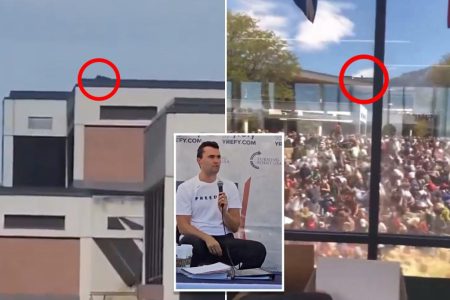The incident involving Sabrina Coyne, a 34-year-old Florida woman, unfolded late on the night of January 24th in Bonita Springs. Coyne was apprehended by Lee County Sheriff deputies outside her ex-husband’s residence after being caught on surveillance video throwing a brick through his window. Bodycam footage released by the authorities documented the confrontation, revealing Coyne’s initial denial of any wrongdoing. Dressed in a short dress and high heels, she claimed to have been merely knocking on the door because her ex-husband wouldn’t let her in, falsely asserting that she lived at the property. However, the surveillance video clearly depicted her launching the brick with her left hand, seemingly recording the act with her right hand. The impact of the brick shattering the window was audible in the video.
The homeowner, Coyne’s ex-husband, had contacted the police after hearing the loud crash followed by insistent banging on his front door. The surveillance footage provided irrefutable evidence against Coyne’s claims of innocence. The video captured the entire sequence of events, from Coyne’s approach to the house to the moment she hurled the brick, and subsequently her knocking on the front door. Despite being confronted with the video evidence, Coyne continued to deny her involvement, repeatedly stating, “I did not break the window,” even as she was being led away in handcuffs.
The brick itself carried sentimental significance, adding a layer of irony to the act of vandalism. It was a commemorative brick marking the former couple’s first date in June 2020, a jet skiing outing. The sheriff’s office highlighted this detail by sharing a photo of the brick on social media. This seemingly romantic keepsake was transformed into a weapon of frustration and anger, symbolizing the deteriorated state of the couple’s relationship. The fact that Coyne chose this specific object to damage her ex-husband’s property suggests a deliberate act of symbolic destruction, perhaps fueled by resentment and a desire to erase a positive memory associated with their past.
Coyne’s actions have resulted in her facing serious legal consequences. The charges against her include criminal mischief and throwing a deadly missile into an occupied dwelling. The former charge addresses the property damage caused by the broken window, while the latter underscores the potential danger posed by throwing a projectile into a residence where someone could have been injured. The severity of these charges reflects the reckless nature of Coyne’s behavior and the potential harm she could have inflicted.
This incident highlights the complexities and potential volatility that can arise in the aftermath of a relationship breakdown. Coyne’s actions, driven by apparent anger and resentment towards her ex-husband, escalated from a domestic dispute to a criminal act. Her denial of responsibility, despite clear video evidence, further complicates the situation and underscores the emotional turmoil she may be experiencing. The case serves as a reminder of the importance of seeking healthy and constructive ways to cope with the challenges of relationship dissolution.
The use of surveillance technology played a crucial role in this case, providing undeniable proof of Coyne’s actions. The bodycam footage also documented her initial interaction with law enforcement and her persistent denial of guilt. The combination of these visual records offers a comprehensive account of the incident, leaving little room for ambiguity. The use of such technology in law enforcement continues to be a valuable tool in ensuring accountability and providing accurate representations of events. This case underscores the effectiveness of surveillance and bodycam footage in capturing and preserving crucial evidence, which ultimately aids in the pursuit of justice and the accurate assessment of circumstances surrounding criminal activity.










